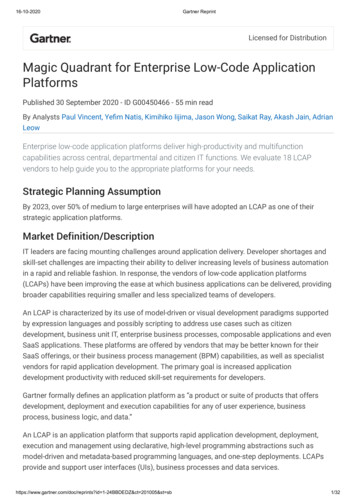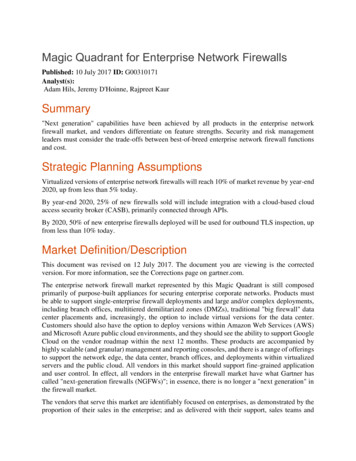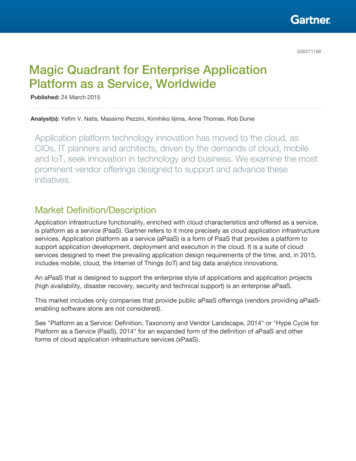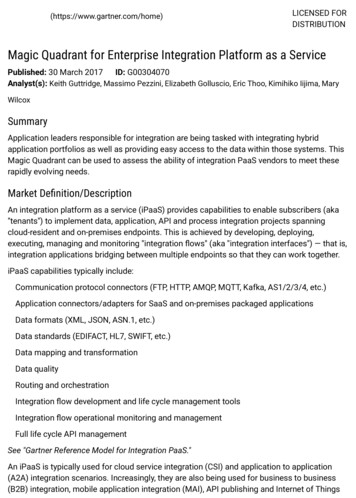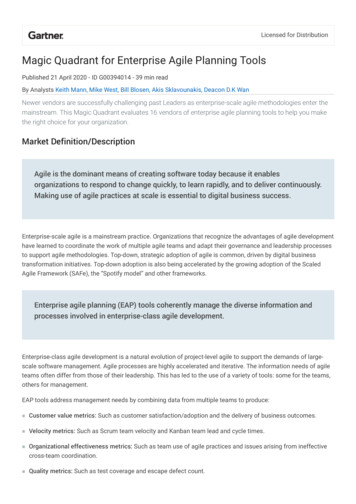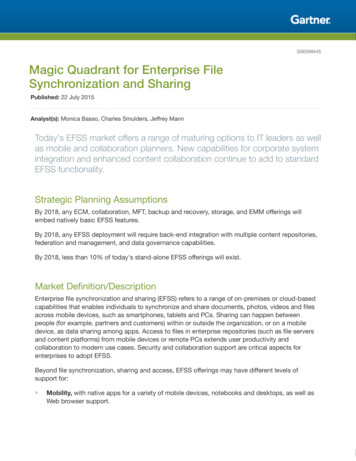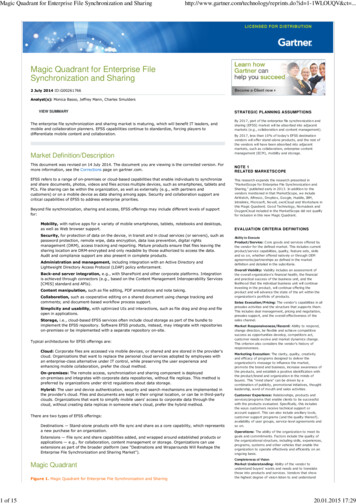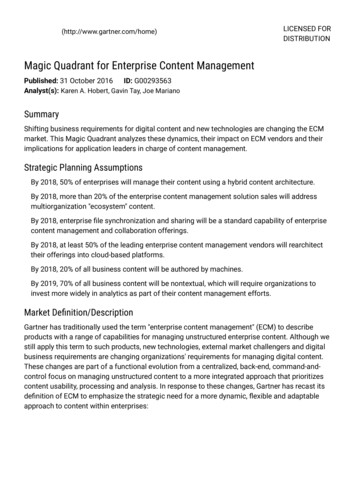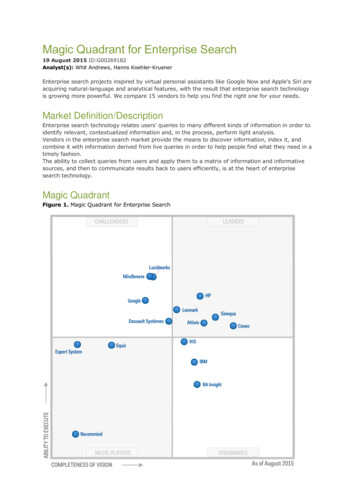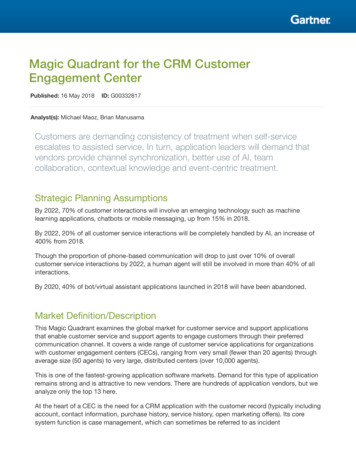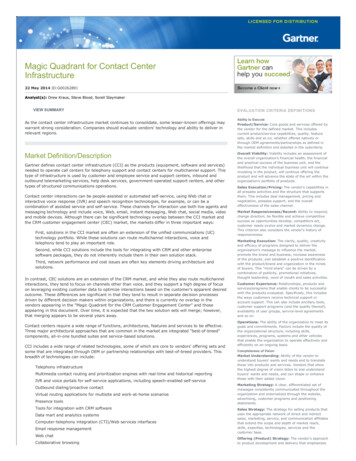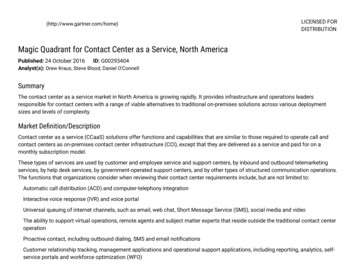
Transcription
This research note is restricted to the personal use of gregory.rosa@mendix.com.Magic Quadrant for Enterprise Low-CodeApplication PlatformsPublished: 8 August 2019ID: G00361584Analyst(s): Paul Vincent, Kimihiko Iijima, Mark Driver, Jason Wong, Yefim NatisEnterprise low-code application platforms offer compelling productivity gainsfor professional and citizen development, as well as speed-of-deliverybenefits. We evaluate 18 vendors to help you identify those with a balanceof technology and business capabilities suited to your enterprise’s needs.Strategic Planning AssumptionsBy 2024, three-quarters of large enterprises will be using at least four low-code development toolsfor both IT application development and citizen development initiatives.By 2024, low-code application development will be responsible for more than 65% of applicationdevelopment activity.Market Definition/DescriptionApplication platforms provide runtime environments for application logic. They manage the lifecycle of an application or application component, and ensure the availability, reliability, scalability,security and monitoring of application logic.A low-code application platform (LCAP) is an application platform that supports rapid applicationdevelopment, one-step deployment, execution and management using declarative, high-levelprogramming abstractions, such as model-driven and metadata-based programming languages.They support the development of user interfaces, business logic and data services, and improveproductivity at the expense of portability across vendors, as compared with conventionalapplication platforms.An enterprise LCAP supports enterprise-class applications. These require high performance,scalability, high availability, disaster recovery, security, SLAs, resource use tracking, technicalsupport from the provider, and API access to and from local and cloud services.Gartner views “no-code” application platforms as part of the LCAP market. “No-code” is amarketing and positioning statement, implying that the platform requires text entry only for formulasThis research note is restricted to the personal use of gregory.rosa@mendix.com.
This research note is restricted to the personal use of gregory.rosa@mendix.com.or simple expressions, all other aspects of application development being enabled by visualmodeling or configuration. The LCAP market includes such no-code platforms.Citizen development is often associated with no-code application development. We consider it aniche within the LCAP market.Magic QuadrantFigure 1. Magic Quadrant for Enterprise Low-Code Application PlatformsSource: Gartner (August 2019)Page 2 of 34Gartner, Inc. G00361584This research note is restricted to the personal use of gregory.rosa@mendix.com.
This research note is restricted to the personal use of gregory.rosa@mendix.com.Vendor Strengths and CautionsAgilePointAgilePoint is a Niche Player. It has a background in business process management (BPM)technology, but undertook an early transition into low-code development tools for automatingbusiness operations. It provides multitenancy using either on-premises deployment or the cloud.Gartner reviewed AgilePoint NX, version 7.Strengths Product: AgilePoint’s BPM background is reflected in its model-driven, Business ProcessModel and Notation (BPMN)-compliant AgilePoint NX environment for building extensibleprocess-centric or data-centric applications, aimed at nontechnical developers. More complexextensions can be built in C# or Visual Basic using AgilePoint’s software development kit. Ecosystem: To assist developers, AgilePoint’s ecosystem store includes popular processpatterns, 70 predefined integrations, 50 domain-specific data entity types and 700 processactivities. AgilePoint also participates in other vendors’ ecosystems; it appears, for example, onthe Salesforce AppExchange and Microsoft AppSource stores. Product vision: AgilePoint’s vision extends to low-code edge computing and the Internet ofThings (IoT), as well as artificial intelligence (AI)-driven development and chatbots, to assist withdigital business initiatives in larger enterprises. Sales execution: AgilePoint focuses on providing value for money and offers concurrent-userand transaction pricing options. Scores from reference customers for AgilePoint’s pricing andvalue for money were higher than those received by most other vendors. It expects its freemiumCommunity Edition to be an enabler of new business.Cautions Overall viability: Although AgilePoint is growing well and has an appropriate partneringstrategy, including white-label resellers, it remains one of the smaller vendors, with a relativelylow average revenue per customer. It has been self-funded to date, but might find it challengingto keep investing at the level needed to compete with other LCAP vendors. Market record: Responses from AgilePoint’s reference customers, supplemented by GartnerPeer Insights reviews, indicate that its customers have tended to focus on reduced skillsrequirements for operations automation, rather than on enterprise rapid application delivery,although some reported achieving the latter. Product strategy: AgilePoint’s participation in Microsoft and Salesforce ecosystems means it ispotentially competing against these ecosystems’ hosts. Although AgilePoint competessuccessfully through its process-centric and value characteristics, these advantages couldeasily be negated, forcing the vendor into a more niche position.Page 3 of 34Gartner, Inc. G00361584This research note is restricted to the personal use of gregory.rosa@mendix.com.
This research note is restricted to the personal use of gregory.rosa@mendix.com. Customer satisfaction: AgilePoint’s reference customers expressed desire for enhancementsto how mobile apps are deployed, together with improved developer assistance in the form ofbetter examples and documentation. AgilePoint states it has made improvements recently withregard to the former desire.AppianAppian is a Leader. It originated in the BPM market and focuses on complex business processesand other applications requiring sophisticated automation, rules and analytics capabilities. Itstechnological differentiators include prebuilt no-code integration with various AI services andsupport for DevOps with automated continuous integration/continuous delivery (CI/CD) forenterprise IT shops. Gartner reviewed Appian version 19.1.Strengths Product: Appian’s LCAP strengths derive from its background in the model-driven intelligentbusiness process management suite (iBPMS) market. Gartner sees Appian’s support forbusiness process automation and modernization of applications as the main reasons forcustomers to choose it. Appian’s ability to handle complex business rules, decisioning andworkflow is also a key differentiator. Innovation: Appian continues to offer innovative low-code technology, with support forchatbots and progressive web apps (PWAs) among its multiexperience capabilities. Market responsiveness: Appian demonstrates enterprise-worthiness through the scale of itsdeployments, which typically span whole organizations and multiple projects. Appian alsoinvests heavily in security certifications and audits, and has one of the most comprehensive setsof certifications for high-security government requirements. Overall viability: In a crowded market with many small, privately owned vendors, Appianstands out as a stable, publicly traded company with a focus on low-code technology. Althoughnot as big as the largest enterprise software vendors, Appian has many enterprise customersand government agencies running its platform, which should ensure its long-term viability in thismarket.Cautions Sales execution: One of the main challenges facing Appian and its customers is the company’ssales execution. Appian’s reference customers reported below-average satisfaction with itscontract evaluation and negotiation, as well as its contract flexibility. Appian has recentlychanged its licensing model to help address this issue, but the effect of the change is not yetknown. Overall, reference customers expressed a lower-than-average level of satisfaction withits sales process. Sales strategy: Appian focuses on larger deals and its pricing strategy means its rate ofcustomer expansion is less than that of other Leaders. Appian’s reference customers reportedbelow-average satisfaction with its pricing.Page 4 of 34Gartner, Inc. G00361584This research note is restricted to the personal use of gregory.rosa@mendix.com.
This research note is restricted to the personal use of gregory.rosa@mendix.com. Product strategy: Compared with some vendors in this Magic Quadrant, Appian’s low-codedevelopment product is more suitable for professional developers in terms of the ease of use ofits proprietary expression and scripting language. Furthermore, reference customers’ overallscore for Appian’s citizen developer support was lower than the average for vendors in thisMagic Quadrant. Customer experience: Appian’s reference customers all recommended it to others, but notunreservedly. They gave lower-than-average scores for time to deployment, which could be theresult of Appian customers choosing it for larger-than-average applications, and for the qualityof Appian’s peer community.Betty BlocksBetty Blocks is a Visionary. Its product, also called Betty Blocks, focuses on the no-code assemblyof applications from components — hence the “Blocks” part of the company’s name. It does thiswhile providing application oversight and governance and support for enterprise-scale usage.Technical differentiators include its cloud-native architecture and React-based UI. The Betty Blocksversion reviewed was current as of the start of 2019.Strengths Market understanding: Betty Blocks differentiates itself as a provider of a citizen developmentplatform for enterprise applications. This reflects a strong vision for a key aspect of the lowcode market. Simple drag-and-drop development and an emphasis on a component reusemodel with associated component repository encourage use of a compositional model forapplication development. Innovation: Betty Blocks’ technical innovation remains advanced, as it uses the Elixir languageto underpin a cloud-native Kubernetes and container-based deployment model with serverlessextensions. This enables customers to extend applications with customizable microapp blocksfor scalable and flexible app delivery. Product: Betty Blocks has a record of delivering standard business applications rapidly. SomeGartner clients report that Betty Blocks delivered straightforward business process automationin a matter of days. Sales execution: Betty Blocks’ reference customers scored it higher than the average forpricing and contract flexibility. This is an important consideration, as one of the most commonconcerns about LCAPs is their pricing.Cautions Overall viability: Although it has grown, Betty Blocks is still one of the smallest vendors in thisMagic Quadrant. Prospective customers should also note the relative smallness of itscommunity and be aware of the potential for it to be acquired. Additionally, the company’s salescoverage is limited primarily to Europe and the U.S.Page 5 of 34Gartner, Inc. G00361584This research note is restricted to the personal use of gregory.rosa@mendix.com.
This research note is restricted to the personal use of gregory.rosa@mendix.com. Customer experience: The nascent market for true citizen development tools is evolving.Reference customers gave Betty Blocks lower-than-average scores for its no-codedevelopment capabilities. Improvements to the end-user experience and further enhancementsto the platform’s usability for citizen developers remain goals on Betty Blocks’ roadmap. Operations: The on-premises version of Betty Blocks’ platform is not the company’s standardoffering. It comes with cloud-native overheads, such as a container infrastructure requirement,that may be incompatible with departmental or small-customer scenarios. Business model: Extending beyond the platform’s no-code capabilities will often requireprofessional development, such as for complex extensions to blocks. This may prompt someusers to revert to co-development with their professional services providers or Betty Blocks’partners.bpm’onlineBpm’online is a Niche Player. It is primarily a BPM and CRM SaaS vendor, its LCAP being providedas part of its BPM capability in the bpm’online platform. Its ethos that “everyone is a developer”prompts its focus on extensions to its prebuilt applications and ecosystem-supplied components.Gartner reviewed bpm’online version 7.13.3.Strengths Product: Bpm’online’s LCAP has a strong focus on BPM functionality. This enables theorchestration of processes across teams and applications, especially in customer-orienteddomains related to its CRM offerings. Market understanding: Bpm’online aims to help business developers without deep technicalskills rapidly build and modify model-driven applications. Its ideal user is a business analystwith a general understanding of web applications and knowledge of BPMN 2.0. Market responsiveness: In addition to supporting the application extension model of a SaaSplus-PaaS (platform as a service) player, bpm’online allows developers to create their owncustom machine learning (ML) models without coding or scripting. These models can predictvalues in different types of field, as well as calculate predictive scores (such as for theprobability of specific events). The business logic for ML is defined using bpm’online’s citizendevelopment environment. Marketing strategy: Bpm’online marketplace is an ecosystem of ready-to-use apps, industrysolutions, templates and development accelerators designed to extend the functionality ofbpm’online’s LCAP. Its community of developers and partners delivers custom applications,extensions, connectors and templates for the bpm’online platform and publishes them onbpm’online marketplace.Cautions Overa
Magic Quadrant for Enterprise Low-Code Application Platforms Published: 8 August 2019 ID: G00361584 Analyst(s): Paul Vincent, Kimihiko Iijima, Mark Driver, Jason Wong, Yefim Natis Enterprise low-code application platforms offer compelling productivity gains for professional and citizen development, as well as speed-of-delivery benefits. We evaluate 18 vendors to help you identify
